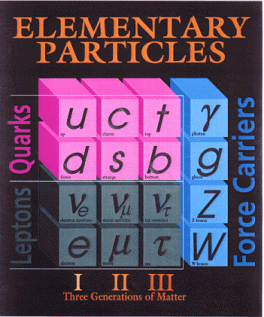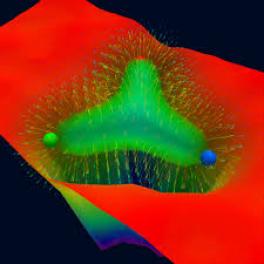http://physics.ohio-state.edu/he_theory/he_theory.html
High energy physics is concerned with the most elementary building blocks of nature and the fundamental forces between them. In the 20th century, physicists learned that all matter is composed of a relatively small number of elementary particles called quarks and leptons. They interact by electroweak and strong forces that are mediated by elementary particles called gauge bosons, namely the photon, the W and Z bosons, and gluons. The known quarks, leptons, and gauge bosons and the electroweak and strong forces are all described by a relativistic quantum field theory known as the Standard Model. It includes the electroweak theory, which unites the weak and electromagnetic interactions and has a symmetry that relates the massless photon and the massive W and Z bosons. The conflict between this symmetry and the very different masses is reconciled by spontaneous symmetry breaking, which requires the existence of an additional particle called the Higgs boson. The recent discovery of the Higgs boson provides the last missing particle in the Standard Model.


There are many reasons to believe that the Standard Model is incomplete, and that there are other elementary particles and fundamental forces in nature. They include the existence of dark matter, oscillations between different neutrinos, the asymmetry between matter and antimatter in the universe, and the equal strength of the three Standard Model forces at some large energy scale. A major effort at Ohio State is trying to discover the new physics beyond the Standard Model. One possibility is the unification of the three Standard Model forces into a single force, possibly through a supersymmetric quantum field theory that also unifies the elementary particles. Another possibility is that the mechanism for spontaneous symmetry breaking is more complicated than in the Standard Model and involves additional Higgs bosons.

Any final theory of physics must incorporate a quantum theory of gravitation. Quantizing gravity has proved to be a difficult problem, but string theory has become established as a consistent theory of quantum gravity. String theory has a rich mathematical structure that is still being explored. A major effort at Ohio State is using string theory to explain the mysterious quantum properties of black holes. Another effort uses string theory to construct extensions of the Standard Model that go beyond quantum field theory.
High Energy Physics Experiment
- ATLAS Group
- CMS Group (CMS - Compact Muon Solenoid)
Experimental High Energy Nuclear Physics - Relativistic Heavy Ion Group
Faculty
PhD, University of Wisconsin, 1981
Quantum field theory
Heavy quarks and quarkonium
Quark-gluon plasma
Perturbative QCD
PhD, Johns Hopkins University, 2006
High energy physics
Higgs physics and supersymetry
LHC phenomenology
Model building
Phenomenology of weak scale physics
PhD, Harvard University, 1986
Elementary particle theory
Lattice gauge theory
Supercomputing
PhD, Tata Institute, 1987
String theory
Black holes
General relativity
PhD, Tel Aviv University, 1976
Physics beyond the Standard Model (grand unified and supersymmetric models)
Problems on the interface of particle physics and astrophysics
Understanding electroweak symmetry breaking and fermion masses
Working on the construction of realistic models of particle physics, based on 10 dimensional superstring theory
PhD, Cornell University, 1978
Lattice gauge theory
Nonperturbative approaches to strong interactions
Heavy quark physics
Tests of the consistency of the Standard Model of particle physics
